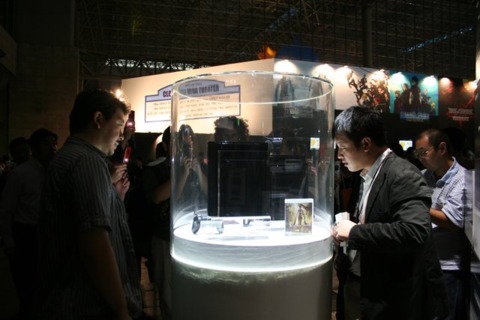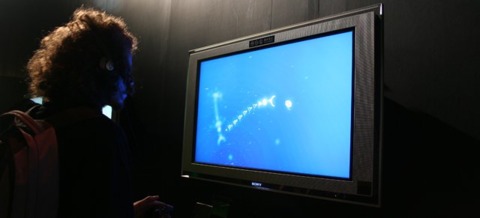TGS 06: Getting down to business
True to its name, Business Day delivered up heaping servings of biz-oriented events and presentations. And young women holding Wii controllers.
TOKYO--One of the more puzzling aspects of the Tokyo Game Show is that it is not actually held in Tokyo. The Makuhari Messe, where the convention is housed, is in the western outskirts of Chiba, and is separated from Tokyo proper by a fairly long train ride. But to be fair, the infamous Tokyo urban sprawl that cyberpunk grandaddy William Gibson loves so much has practically merged the two cities. The Makuhari area was renovated to create a "city of the future," and if future cities look like huge, desolate concrete slabs surrounded by massive hotels, then the urban planners got it spot-on.

There were reporters from media outlets around the world lined up at the doors of the Makuhari Messe Friday morning. Press registration opened around 9 a.m. and 15 minutes later the line for foreign correspondents was about 40 strong. Day one at TGS was Business Day, meaning attendance was limited to those with a connection to the media, companies within the industry, and fans who managed to beg, borrow, or steal an invitation.
At 10 a.m., two things happened. First, the doors to the cavernous exhibition hall, the largest in the Tokyo/Chiba area, opened, letting in the waiting photographers, reporters, and industry bigwigs. At the same time, in the Messe's International Conference Hall, Ken Kutaragi was beginning his keynote speech. Or rather, he was supposed to--the speech was delayed a few minutes while an announcer politely informed the spectators that they were expecting a full house, and asked the guests to pack in tight and stick around for the show.

When the speech kicked off properly, Sony Entertainment Inc. president and group CEO Ken Kutaragi, bathed in the strobes of the gathered photographers, talked for a little over an hour about the stunning growth of technology over the past few decades and the future of digital entertainment. He talked about generating three-dimensional models of cities from satellite images, the possibility of actually connecting the human brain to the computer--"jacking in" was the expression he used--and the migration of content from local storage devices to the network. Peppering his lecture were montages of PS3 game footage, from Gundam: Target in Sight to Final Fantasy XIII.

What he didn't address much was PlayStation 3 strategy, despite the title of the speech, "Next-Generation Entertainment Created by the PS3." For example, while he did stress the importance of the network to gaming, he did not really go into great depth about Sony's online strategy for the PS3. However, he did succeed in painting a very vivid picture of what high-tech entertainment might look like some 15 years down the road, and positioned the PS3 at the vanguard of this revolution. The cake of his speech was iced by a brief Q&A session in which he announced that every PS3 would come equipped with an HDMI port, and that Sony was instituting a prelaunch price drop for the standard PS3 package in Japan.
Yoichi Wada, CESA chairman and Square president, then took center stage. While Kutargi's keynote was bold and future-oriented, Wada quickly brought the audience down to earth with a sobering dose of reality. He used his speech to emphasize that while the game market is doing exceptionally well and has great potential, developers would have to make big changes in how they do business in order to keep up with a rapidly diversifying market.
Moving to the showroom floor, the main halls were absolutely packed. Although the number of visitors on Business Day is necessarily limited, virtually any and all space not occupied by booths was filled by a constantly moving river of bodies. The main current of visitors coiled around the major booths of Sony, Microsoft, Capcom, and Square Enix, while eddies of stray visitors milled around in the open pockets, snapping pictures and looking at the games, or just catching their collective breath.
Young women in colorful costumes, referred to as "companions" by the Japanese gaming press, were on hand to answer questions regarding their employer's products, or to pose for photographs for cosplay enthusiasts. The only area that was sparsely populated was the corner of the seventh hall, where the various game-related educational institutes had set up camp--perhaps not a good sign for those looking forward to the next generation of developers. However, with the density of warm mammalian bodies this high on the supposedly exclusive Business Day, tomorrow--the first day the show is open to the public--is guaranteed to be utter pandemonium.
For more from day one, including hands-on impressions of some of the biggest games of the show, check out GameSpot's full coverage of the
Got a news tip or want to contact us directly? Email news@gamespot.com
Join the conversation